Steve Cable continues his analysis of Probe’s 2020 survey of American religious views moving over to consider their response to sexual mores of today and how they navigate religion and science.
The previous reports on Probe Survey 2020 were primarily focused on religious beliefs and practices. In this report, we will look at how these beliefs impact Americans as they deal with sexual issues and with navigating the relationship between religion and science. In general, the survey results confirm a continuing degradation in Americans’, and particularly Born Agains’, view of sex within a heterosexual marriage. We find that fewer than one in five Born Again Protestants affirm a biblical view in this area. On the other hand, Americans still tend to consider religious views at least as important as scientific positions in establishing their beliefs.
American Sexual Attitudes and Behaviors
We asked four questions regarding sexual attitudes and behaviors in this survey.
1. Sex among unmarried people is always a mistake: from Agree Strongly to Disagree Strongly
2. Viewing explicit sexual material in a movie, on the internet, or some other source is:
a. To be avoided
b. Acceptable if no one is physically or emotionally harmed in them.
c. A matter of personal choice
d. Not a problem if you enjoy it
e. Don’t know
3. Living with someone in a sexual relationship before marriage:
a. Might be helpful but should be entered into with caution.
b. Just makes sense in today’s cultural environment.
c. Will have a negative effect on the relationship.
d. Should be avoided as not our best choice as instructed by God
4. People attracted to same sex relationships are:
a. To be loved and affirmed in their sexual choices.
b. To be avoided as much as possible.
c. To be accepted while hoping they realize there is a better way.
d. To be loved and told God’s truth regarding our sexual practices.
First, let’s see how the different religious affiliations impact the answers to these questions.
Sex Among Unmarried People
First, let us establish the biblical standard for sexual relations outside of marriage. Is there clear teaching on this topic? Consider Jesus’ discussion in the Sermon on the Mount where He said, “You have heard that it was said, ‘Do not commit adultery.’ But I say to you that whoever looks at a woman to desire her has already committed adultery with her in his heart.”{1}
In 1 Thessalonians 4:3, Paul writes, “For this is God’s will: that you become holy, that you keep away from sexual immorality.” And then in 1 Peter 2:11, Peter writes, “I urge you to abstain from the passions of the flesh, which wage war against your soul.” It is very clear that the biblical standard calls for all sexual relations to occur within a marriage between one man and one woman.
 Results from the first question are plotted in Figure 1. As shown, here and in the next three graphs, we will look at those ages 18 through 29 next to those ages 40 through 55 to see if there are differences based on age. If there is a trend or variation seen in the 30 through 39 age group, then that one is also shown as seen for Born Again Protestants in Figure 1.
Results from the first question are plotted in Figure 1. As shown, here and in the next three graphs, we will look at those ages 18 through 29 next to those ages 40 through 55 to see if there are differences based on age. If there is a trend or variation seen in the 30 through 39 age group, then that one is also shown as seen for Born Again Protestants in Figure 1.
The graph shows the older group of Born Again Protestants is much more likely to Strongly Agree that fornication is always a mistake than the youngest group, dropping from almost one half to a little over one quarter, 46% to 29%. Over two thirds of Younger Born Again Protestants have adopted the common view of the culture that sex and marriage are not necessarily related. Note that even among the older group, less than half of them strongly agree that sex outside of marriage is always a mistake.
Looking across other religious affiliations, we see that the vast majority said they Disagreed or Strongly Disagreed with this statement{2}. They generally believe that sex outside of marriage by unmarried people is not an issue. This is particularly true of the Unaffiliated with close to 90% (nine out of ten) disagreeing.
How have these views changed among born again young adult individuals over the last decade? Looking at the GSS survey from 2008, we find that over one in three (37%) Born Again Christians ages 18 through 29 agree with the statement, “If a man and woman have sex relations before marriage, I think it is always wrong.” Now in 2020, we find that over one quarter (27%) of Born Again Christians agree that it is always wrong. Although the questions asked were not identical, they are close enough to indicate that the drop of ten percentage points is a significant decline in young adult, Born Again Christians who take a biblical position on sexual activity outside of marriage.
 Pornography.
Pornography.
The second question deals with views on the acceptability of viewing pornographic material. What does the Bible tell us about feeding our minds with sexually immoral material? Jesus tells us in Matthew 15:19, “For out of the heart come evil ideas, murder, adultery, sexual immorality, theft, false testimony, slander.” We are warned in 1 Corinthians 6:18, “Flee sexual immorality! Every sin a person commits is outside of the body but the immoral person sins against his own body.” And further in Ephesians 5:3, “But among you there must not be either sexual immorality, impurity of any kind, or greed, as these are not fitting for the saints.” Clearly, avoiding sexual immorality in all forms includes avoiding explicit sexual material.
The results are shown in Figure 2. Once again, we see that Born Again Protestants are much more likely to say that we should avoid exposure to such material. Both the younger group and the older have more than 50% who say it is “to be avoided.” However, the data also shows over four out of ten Born Again Protestants believe it is usually okay. Given what we know about the negative effects of pornography on healthy living and relationships, this result is surprising.
All the other religious affiliations have only a small percentage of people who think that explicit sexual material should be avoided. Only about one in five Other Protestants and Catholics affirm that pornography is to be avoided. Once again, the Unaffiliated lag those affiliated with some religion having only about one in twenty (5%) that think pornography should be avoided.
For those who are not Born Again Protestants, around 10% to 20% say that such material is okay if no one is hurt in them. These people fail to realize that the person being hurt by these materials is themselves and their loved ones. More surprisingly, the vast majority of these people selected “a matter of personal choice” or “not a problem if you enjoy it,” implying that if people are shown being harmed in this pornographic material, that is perfectly okay if you enjoy it or want to put up with it.
Living Together Before Marriage
What does the Bible tell us about living in a sexual relationship before marriage? In Colossians 3:5, Paul states, “So put to death whatever in your nature belongs to the earth: sexual immorality, impurity, shameful passion, evil desire, and greed which is idolatry.” The current philosophy of “try before you buy” is popular but totally contrary to biblical instruction for a rich, fulfilling life. This philosophy clearly “belongs to the earth.”
 The third question examines views on whether it is a good thing to live together in a sexual relationship before committing to marriage. The results are summarized in Figure 3. This is another question where Born Again Protestants show a significant difference based on age. The older group, 40 through 55, shows almost 60% who say that it should be avoided as instructed by God. The younger group, 18 through 29, shows only 40% with the same viewpoint. Across all age ranges only about one half of Born Again Protestants say that this practice should be avoided. So, even among this group, over half believe that it is okay and might be helpful.
The third question examines views on whether it is a good thing to live together in a sexual relationship before committing to marriage. The results are summarized in Figure 3. This is another question where Born Again Protestants show a significant difference based on age. The older group, 40 through 55, shows almost 60% who say that it should be avoided as instructed by God. The younger group, 18 through 29, shows only 40% with the same viewpoint. Across all age ranges only about one half of Born Again Protestants say that this practice should be avoided. So, even among this group, over half believe that it is okay and might be helpful.
Once again, this question reveals a stark difference between Born Again Protestants and all other religious affiliations. Other Christian groups show much fewer than one in five adherents who believe this practice should be avoided. And we see the Unaffiliated lead the other viewpoint, with about nine out of ten of them saying the practice “might be helpful” or “makes sense in today’s culture.”
Same Sex Relationships.
The fourth question deals with how people react toward those who profess to have a sexual attraction towards those of the same gender. What does the Bible say about same sex relationships? Let’s consider the instruction from 1 Corinthians 6:9b-11, “Do not be deceived! The sexually immoral, idolators, adulterers, passive homosexual partners, practicing homosexuals, thieves, the greedy, drunkards, the verbally abusive, and swindlers will not inherit the kingdom of God. Some of you once lived this way. But you were washed, you were sanctified, you were justified in the name of the Lord Jesus Christ and by the Spirit of our God.”
 The verse above tells us two things. First, that someone who is given over to homosexual activity (like those given over to idolatry, sexual immorality, and greed) are not true followers of Christ. Even in Paul’s era, many were apparently saying they would inherit the kingdom of God and so Paul begins the statement by saying “Do not be deceived.” But it also clearly states that such a one can be washed, sanctified and justified in Jesus Christ. As Christians, we should love them and tell them the truth that God has a better way for their life.
The verse above tells us two things. First, that someone who is given over to homosexual activity (like those given over to idolatry, sexual immorality, and greed) are not true followers of Christ. Even in Paul’s era, many were apparently saying they would inherit the kingdom of God and so Paul begins the statement by saying “Do not be deceived.” But it also clearly states that such a one can be washed, sanctified and justified in Jesus Christ. As Christians, we should love them and tell them the truth that God has a better way for their life.
Note that our question does not distinguish between those experiencing same sex attraction and those actively involved in living out their attraction through homosexual activity. Both categories of people need to be loved and told the truth.
The results for this question are summarized in Figure 4. As shown, we see some difference based on age for Born Again Protestants. However, it is not as pronounced as for the question on fornication above. Looked at as a group between age 18 and 55, less than one half of Born Again Protestants selected loving them and telling them what the Bible says about homosexual practices.
Once again, all other groups are much less likely to take a biblical position. However, when we add in the answer about “accepting them while hoping they find a better way’, the other religious groups (excluding the Unaffiliated) show almost four in ten who desire them to find a better way.
Note that Other Protestants are most likely at 20% (about one out of five) to say they would try to avoid people attracted to the same gender.
Combining Questions for Born Again Protestants.
How many Born Again Protestants take a clear biblical view of all four questions concerning sexual attitudes and behaviors? Results are shown in the adjacent chart. The chart begins with results by age for the first question concerning fornication. As you move to the right, additional questions are added to the questions already addressed to the left. Thus, the bars on the right include those who took a biblical position on all four of the questions.
 Clearly, ones in the older group are more likely to take a biblical view on sexual behavior. In fact, on the far right, we see that those 40 to 55 are twice as likely as those 18 to 29 to hold to a biblical view. However, more important, is that over 80% of the younger ages and over 75% of the oldest ages do not hold to a biblical view on these combined topics regarding sexual behavior.
Clearly, ones in the older group are more likely to take a biblical view on sexual behavior. In fact, on the far right, we see that those 40 to 55 are twice as likely as those 18 to 29 to hold to a biblical view. However, more important, is that over 80% of the younger ages and over 75% of the oldest ages do not hold to a biblical view on these combined topics regarding sexual behavior.
To understand how disturbing these results should be, consider Born Again Christians with a biblical view on sexuality as a percentage of the entire United States population. The results are 2% for 18 through 29, 3% for 30 through 39, and a whopping 6% for 40 through 55. In other words, a slim remnant of adults in America hold to a biblical view of sexuality. A secular view promoting no relationship between sexual behavior and marriage and no limits on satisfying one’s lusts currently dominates our national thinking.
Don’t Do What You Say You Will Do.
We will address this topic more fully under Topic 10 but it is relevant to thinking about the Combining Question topic above. We asked this question:
When you are faced with a personal moral choice, which one of the following statements best describes how you will most likely decide what to do?
One of the answer choices is “Do what biblical principles teach.”
Almost half (47%) of Born Again Protestant young adults (18 through 39) selected that answer. They would follow biblical principles in making moral decisions. Yet as just seen, only about 15% of Born Again Protestant young adults selected biblical principles on all four questions regarding sexual behaviors.
Although we can’t be certain, it appears that many Born Again Protestant young adults either don’t know what topics are covered under moral choices OR they don’t know what biblical principles teach OR both. Clearly, almost half of Born Again Protestant young adults think that they are choosing to think biblically about moral choices, but most of them are not living the way they think they are.
Responding to These Results on Sexual Attitudes
All of the results presented above show that a large majority of young adult, Born Again Protestants do not adhere to a biblical position on topics related to sexual morality. The data also shows that when Born Again Protestants enter the world of higher education and secular careers, they are surrounded by an even greater majority of people who believe that pretty much anything is acceptable in the area of sexual relations. Among other conclusions, we can be sure that these two data points tell us that while young adults were involved in church as teenagers, they were not adequately taught the basics of Christian doctrine in the area of sexuality and did not receive a good explanation as to why the Christian attitudes are much, much better than the free license rampant in our society today.
Christian teaching on sexuality must occur more frequently from the pulpit, in bible studies, in small group times. If we think that parents as the only source of information are sufficient to set up young Christians to be an example of godly sexuality, the data says “not so fast.” However, we do not equip parents to discuss these matters with their children. We cannot allow their peers to set the bar on acceptable behavior.
American Attitudes Concerning Science and Religion
We included three questions probing people’s views on the relationship between science and religion. The first question relates to any apparent conflicts between current scientific theories and their beliefs based on their religion. From the answers, one can tell whether the respondent puts more credence in current scientific theories or in their religious beliefs. The question is:
Question #1: When apparent conflicts appear between science and religious teachings, one should:
1. Ignore science, accepting that when science learns more it will agree with your
religion.
2. Examine your religious teachings to determine if the scriptures are in conflict or it
is just someone’s interpretation of the scriptures that conflict.
3. Change your religious views to align with current scientific views.
4. Abandon your religion as being false.
 The first two answers are consistent with a Basic/Enhanced Biblical Worldview, reflecting 1) a view that their scripture is informed by a higher source of truth than simple science can draw upon, 2) a recognition that generally accepted scientific viewpoints have often changed over time, and 3) on the type of scientific questions being addressed here, there are in most cases a variety of theories supported by different groups of scientists. The second answer includes the possibility that the person’s holy scriptures do not directly address the topic at hand, but that some religious leaders have inferred a position on the topic from their interpretation of scriptures.
The first two answers are consistent with a Basic/Enhanced Biblical Worldview, reflecting 1) a view that their scripture is informed by a higher source of truth than simple science can draw upon, 2) a recognition that generally accepted scientific viewpoints have often changed over time, and 3) on the type of scientific questions being addressed here, there are in most cases a variety of theories supported by different groups of scientists. The second answer includes the possibility that the person’s holy scriptures do not directly address the topic at hand, but that some religious leaders have inferred a position on the topic from their interpretation of scriptures.
The second two answers, i.e. 3 and 4, reflect a view that scientific teaching communicates truth that religious teachings are unable to counter. The third answer results in a religious viewpoint that will vary over time as scientific ideas gain or fall out of favor in the scientific community.
As shown in the figure, the majority of American young adults do not accept that science is infallible (by supporting answers 3 or 4). Less than 10% of Born Again Protestants selected one of these answers. And even among the Unaffiliated, less than half of them selected an answer where scientific theories trump other sources of beliefs.
At the same time, those who selected a view that ignores science all together (answer 1) were a small minority as well. Less than one in five (20%) of the Born Again Protestants and slightly over one out of ten for the other religious groups.
So well over 50% of all religious groups selected answer number 2, showing a willingness to go against science but also a desire to meld the views of science into their religious views. We did not ask a follow up question as to what they would do if they determined there was an unresolvable conflict with the current position supported by most scientists. There are not many unresolvable conflicts if one is willing to adopt a position supported by a reputable minority of scientists, e.g. intelligent design.
Question #2: My understanding of human origins is the result of:
1. Using the Bible alone with no regard for the findings of science.
2. Using science to better understand what the Bible teaches us about origins.
3. Not sure
4. Accepting a completely naturalistic view, i.e. no intelligence involved in the process.
 Note these answers follow a similar pattern to those of the first question, but now they are applied to a specific question where many people assume there is no meeting ground between science and religion.
Note these answers follow a similar pattern to those of the first question, but now they are applied to a specific question where many people assume there is no meeting ground between science and religion.
The answers are shown in the adjacent graph. On this more specific question, the percentage of each religious group that is going to look at the Bible alone for their understanding hovers around 30% for all religious groups but plummets to under 8% for the Unaffiliated.
Conversely, only the Unaffiliated show more than three out of ten who “accept a completely naturalistic view” (choice #4). Born Again Protestants show only about one out of eight who select such a view. This result is amazing given the concerted push by some educators to force our students to accept a completely naturalistic view of creation. However it is consistent with the current state of the research on the origins of man, including new reports from 2021.{3}
The majority for each group of people selected “Not sure” or said they would use science to help them better understand what the Bible teaches.
Question #3: All real scientists believe that science is the only source of real truth.
The potential answers ranged from Strongly agree to Strongly disagree and included Neither agree or disagree.
 First note that if we strictly define real scientists as individuals meeting these qualifications—1) a Ph.D. in a scientific field, 2) actively involved in the field, and 3) published in reputable scientific journals—we will find many scientists who agree that there are other sources of truth outside of science. So, we can say with confidence that the statement in question #3 is objectively, verifiably not true. However, there are certainly some believers in scientism [the belief that science is the only way to know ultimate truth] who claim the statement is true. They accomplish this trick by claiming that anyone who does not believe that science is the only source of real truth cannot by definition be a real scientist.{4} In other words, they use circular reasoning.
First note that if we strictly define real scientists as individuals meeting these qualifications—1) a Ph.D. in a scientific field, 2) actively involved in the field, and 3) published in reputable scientific journals—we will find many scientists who agree that there are other sources of truth outside of science. So, we can say with confidence that the statement in question #3 is objectively, verifiably not true. However, there are certainly some believers in scientism [the belief that science is the only way to know ultimate truth] who claim the statement is true. They accomplish this trick by claiming that anyone who does not believe that science is the only source of real truth cannot by definition be a real scientist.{4} In other words, they use circular reasoning.
But there is certainly a movement to instill scientism as the favored viewpoint in society.{5} How successful are these proponents of scientism? Looking at the answer shown in the adjacent chart will throw some light on this question.
We would like to see the answer: Strongly Disagree. This answer aligns with the objective truth discussed above. But what we find is that only one out of five (20%) of Born Again Protestants profess this view. Among Other Protestants and Catholics only about one out of twenty (5%) profess this view. Adding some uncertainty by adding those who say they Disagree, increases those amounts to two out of five (40%) for Born Again Protestants and one out of five (20%) for Other Protestants and Catholics.
Those who agree with the statement range from one out of four (25%) Born Again Protestants up to nearly one half (almost 50%) of Other Protestants and Catholics. Clearly, the proponents of scientism have done a good job of skewing our understanding of who scientists are and what they believe.
Combining the Questions
 What do the results look like when we combine these questions? In our opinion, there are a number of different answers that could be consistent with a biblical worldview. Starting with the strictest view of relying on the Bible rather than science and then adding in those who would look at the results from science to obtain a clearer understanding of what the Bible teaches or those areas where the Bible is silent. Then, we add in their view on scientism which as already discussed is demonstrated by a long list of scientists who disagree to be false, thus being a source of strong disagreement.
What do the results look like when we combine these questions? In our opinion, there are a number of different answers that could be consistent with a biblical worldview. Starting with the strictest view of relying on the Bible rather than science and then adding in those who would look at the results from science to obtain a clearer understanding of what the Bible teaches or those areas where the Bible is silent. Then, we add in their view on scientism which as already discussed is demonstrated by a long list of scientists who disagree to be false, thus being a source of strong disagreement.
The results from this comparison are shown in the adjacent figure. The first thing to notice is that the percentage of Born Again Protestants who take a more fundamental position, i.e. science should be ignored as a source of information, is low for one question and goes down to only a few percentage points when all three questions are combined.
The right hand side of the chart considers all combinations of answers that reflect a commitment to biblical truth above current scientific theories combined with a willingness to consider what science has to offer. As shown, the combination of the first two questions has a large percent of Born Again Protestants, ranging from 55% for the youngest age group and growing to over 65% for the older age group. Since only a minority of Born Again Protestants stated Strongly Disagree that all scientists are adherents of scientism, when we add that question to the mix on the far right, we see less than one in five take a Biblical position on all three.
Effect of a Basic Biblical Worldview.
 A natural question to ask is, “Does having a Basic Biblical Worldview correlate with having a biblical view on these science issues?” We can look at this question by comparing Born Again Protestants with a Basic Biblical Worldview with Born Again Protestants without a Basic BWV. The results are shown in the adjacent figure.
A natural question to ask is, “Does having a Basic Biblical Worldview correlate with having a biblical view on these science issues?” We can look at this question by comparing Born Again Protestants with a Basic Biblical Worldview with Born Again Protestants without a Basic BWV. The results are shown in the adjacent figure.
At a top level, we can see a correlation between a Basic Biblical Worldview and a biblical understanding of the relationship with science. This correlation appears to be strongest with those ages 18 through 29. We see that those with a Basic Biblical Worldview are about twice as likely to have a biblical view on all three of the questions related to science.
Responding to These Results on Science and Religion
As we can see from the first two science questions above, the majority of Americans do not buy into the idea that the only real source of truth is science. They don’t believe that scientific positions automatically take precedence over their religious beliefs. Perhaps one factor supporting this stance is an understanding that scientific hypotheses and positions have changed fairly often over the years, particularly in the areas of the origin of life and the role of evolutionary processes on our current bounty of life forms. Certainly, it is not the public school system which has attempted to promote concepts which current day scientists studying the field do not support.
However, Americans do have a skewed view of scientism, with a vast majority believing that all real scientists support this religious concept. This position is a little surprising given that the view is demonstrably false.
In one area, sexual behavior, even American Christians have thrown out the teaching of the Bible. At the same time, they are resisting the call to make science the ultimate source of truth.
Notes
1. Matthew 5:27-28
2. There is also a small number of those answering Don’t Know included in the number of those who do not state that they Strongly Agree or Agree Somewhat with the statement.
3. In March, Nobel Prize-winning physicist Brian Josephson declared that “intelligent design is valid science.” In April, researchers writing in the journal Current Biology asked whether Darwin’s “tree of life” should “be abandoned.”
4. See for example: Daniel Dennett, Breaking the Spell, 2006.
5. See for example the book by J. P. Moreland, Scientism and Secularism, 2018.
© 2021 Probe Ministries
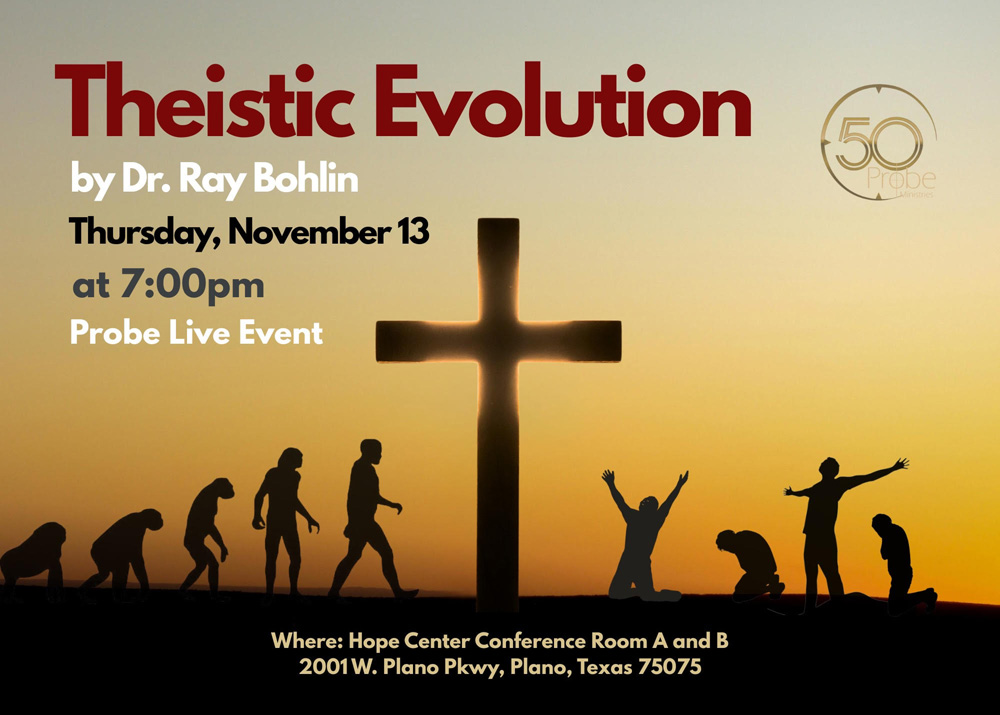
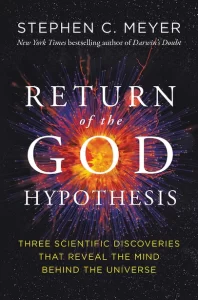 In this article I give an overview of Stephen Meyer’s Return of The God Hypothesis: Three Scientific Discoveries that Reveal the Mind Behind the Universe
In this article I give an overview of Stephen Meyer’s Return of The God Hypothesis: Three Scientific Discoveries that Reveal the Mind Behind the Universe 
 Results from the first question are plotted in Figure 1. As shown, here and in the next three graphs, we will look at those ages 18 through 29 next to those ages 40 through 55 to see if there are differences based on age. If there is a trend or variation seen in the 30 through 39 age group, then that one is also shown as seen for Born Again Protestants in Figure 1.
Results from the first question are plotted in Figure 1. As shown, here and in the next three graphs, we will look at those ages 18 through 29 next to those ages 40 through 55 to see if there are differences based on age. If there is a trend or variation seen in the 30 through 39 age group, then that one is also shown as seen for Born Again Protestants in Figure 1. Pornography.
Pornography. The third question examines views on whether it is a good thing to live together in a sexual relationship before committing to marriage. The results are summarized in Figure 3. This is another question where Born Again Protestants show a significant difference based on age. The older group, 40 through 55, shows almost 60% who say that it should be avoided as instructed by God. The younger group, 18 through 29, shows only 40% with the same viewpoint. Across all age ranges only about one half of Born Again Protestants say that this practice should be avoided. So, even among this group, over half believe that it is okay and might be helpful.
The third question examines views on whether it is a good thing to live together in a sexual relationship before committing to marriage. The results are summarized in Figure 3. This is another question where Born Again Protestants show a significant difference based on age. The older group, 40 through 55, shows almost 60% who say that it should be avoided as instructed by God. The younger group, 18 through 29, shows only 40% with the same viewpoint. Across all age ranges only about one half of Born Again Protestants say that this practice should be avoided. So, even among this group, over half believe that it is okay and might be helpful. The verse above tells us two things. First, that someone who is given over to homosexual activity (like those given over to idolatry, sexual immorality, and greed) are not true followers of Christ. Even in Paul’s era, many were apparently saying they would inherit the kingdom of God and so Paul begins the statement by saying “Do not be deceived.” But it also clearly states that such a one can be washed, sanctified and justified in Jesus Christ. As Christians, we should love them and tell them the truth that God has a better way for their life.
The verse above tells us two things. First, that someone who is given over to homosexual activity (like those given over to idolatry, sexual immorality, and greed) are not true followers of Christ. Even in Paul’s era, many were apparently saying they would inherit the kingdom of God and so Paul begins the statement by saying “Do not be deceived.” But it also clearly states that such a one can be washed, sanctified and justified in Jesus Christ. As Christians, we should love them and tell them the truth that God has a better way for their life. Clearly, ones in the older group are more likely to take a biblical view on sexual behavior. In fact, on the far right, we see that those 40 to 55 are twice as likely as those 18 to 29 to hold to a biblical view. However, more important, is that over 80% of the younger ages and over 75% of the oldest ages do not hold to a biblical view on these combined topics regarding sexual behavior.
Clearly, ones in the older group are more likely to take a biblical view on sexual behavior. In fact, on the far right, we see that those 40 to 55 are twice as likely as those 18 to 29 to hold to a biblical view. However, more important, is that over 80% of the younger ages and over 75% of the oldest ages do not hold to a biblical view on these combined topics regarding sexual behavior. The first two answers are consistent with a Basic/Enhanced Biblical Worldview, reflecting 1) a view that their scripture is informed by a higher source of truth than simple science can draw upon, 2) a recognition that generally accepted scientific viewpoints have often changed over time, and 3) on the type of scientific questions being addressed here, there are in most cases a variety of theories supported by different groups of scientists. The second answer includes the possibility that the person’s holy scriptures do not directly address the topic at hand, but that some religious leaders have inferred a position on the topic from their interpretation of scriptures.
The first two answers are consistent with a Basic/Enhanced Biblical Worldview, reflecting 1) a view that their scripture is informed by a higher source of truth than simple science can draw upon, 2) a recognition that generally accepted scientific viewpoints have often changed over time, and 3) on the type of scientific questions being addressed here, there are in most cases a variety of theories supported by different groups of scientists. The second answer includes the possibility that the person’s holy scriptures do not directly address the topic at hand, but that some religious leaders have inferred a position on the topic from their interpretation of scriptures. Note these answers follow a similar pattern to those of the first question, but now they are applied to a specific question where many people assume there is no meeting ground between science and religion.
Note these answers follow a similar pattern to those of the first question, but now they are applied to a specific question where many people assume there is no meeting ground between science and religion. First note that if we strictly define real scientists as individuals meeting these qualifications—1) a Ph.D. in a scientific field, 2) actively involved in the field, and 3) published in reputable scientific journals—we will find many scientists who agree that there are other sources of truth outside of science. So, we can say with confidence that the statement in question #3 is objectively, verifiably not true. However, there are certainly some believers in scientism [the belief that science is the only way to know ultimate truth] who claim the statement is true. They accomplish this trick by claiming that anyone who does not believe that science is the only source of real truth cannot by definition be a real scientist.
First note that if we strictly define real scientists as individuals meeting these qualifications—1) a Ph.D. in a scientific field, 2) actively involved in the field, and 3) published in reputable scientific journals—we will find many scientists who agree that there are other sources of truth outside of science. So, we can say with confidence that the statement in question #3 is objectively, verifiably not true. However, there are certainly some believers in scientism [the belief that science is the only way to know ultimate truth] who claim the statement is true. They accomplish this trick by claiming that anyone who does not believe that science is the only source of real truth cannot by definition be a real scientist. What do the results look like when we combine these questions? In our opinion, there are a number of different answers that could be consistent with a biblical worldview. Starting with the strictest view of relying on the Bible rather than science and then adding in those who would look at the results from science to obtain a clearer understanding of what the Bible teaches or those areas where the Bible is silent. Then, we add in their view on scientism which as already discussed is demonstrated by a long list of scientists who disagree to be false, thus being a source of strong disagreement.
What do the results look like when we combine these questions? In our opinion, there are a number of different answers that could be consistent with a biblical worldview. Starting with the strictest view of relying on the Bible rather than science and then adding in those who would look at the results from science to obtain a clearer understanding of what the Bible teaches or those areas where the Bible is silent. Then, we add in their view on scientism which as already discussed is demonstrated by a long list of scientists who disagree to be false, thus being a source of strong disagreement. A natural question to ask is, “Does having a Basic Biblical Worldview correlate with having a biblical view on these science issues?” We can look at this question by comparing Born Again Protestants with a Basic Biblical Worldview with Born Again Protestants without a Basic BWV. The results are shown in the adjacent figure.
A natural question to ask is, “Does having a Basic Biblical Worldview correlate with having a biblical view on these science issues?” We can look at this question by comparing Born Again Protestants with a Basic Biblical Worldview with Born Again Protestants without a Basic BWV. The results are shown in the adjacent figure.
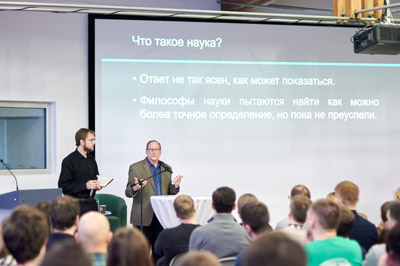
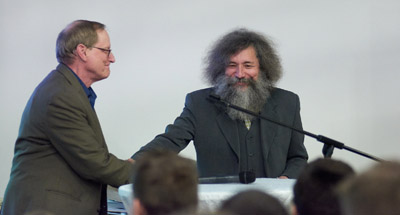 Concerned about making his flight back to Moscow, Dr. Gelfand gathered up his things. He was very surprised when Ray came over and, smiling, shook his hand after having been insulted several times during the debate. Christian kindness and compassion is its own kind of culture.
Concerned about making his flight back to Moscow, Dr. Gelfand gathered up his things. He was very surprised when Ray came over and, smiling, shook his hand after having been insulted several times during the debate. Christian kindness and compassion is its own kind of culture.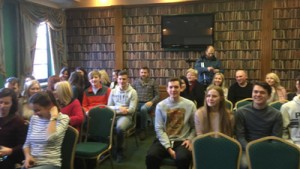 The next morning was the second debate, arranged by the pastor of Brest Bible Church, who had seen the YouTube videos of Ray’s 2016 debate and 2017 lecture, and really wanted him to come to his city.
The next morning was the second debate, arranged by the pastor of Brest Bible Church, who had seen the YouTube videos of Ray’s 2016 debate and 2017 lecture, and really wanted him to come to his city.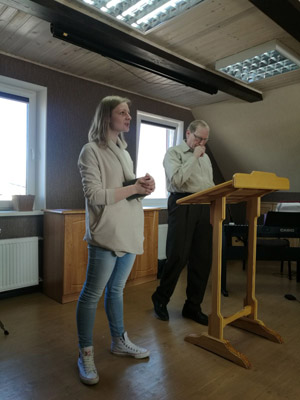 On Sunday, their last day, both Todd and Ray gave a short 20-minute talk in the small house church of a pastor and his wife who have become good friends of the Bohlins. That night at another small church, Ray answered lots of questions about the Minsk debate.
On Sunday, their last day, both Todd and Ray gave a short 20-minute talk in the small house church of a pastor and his wife who have become good friends of the Bohlins. That night at another small church, Ray answered lots of questions about the Minsk debate.